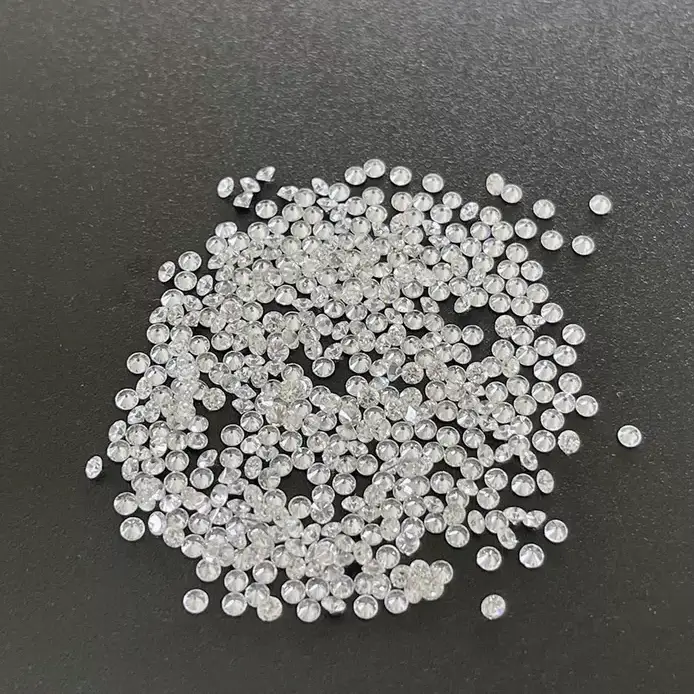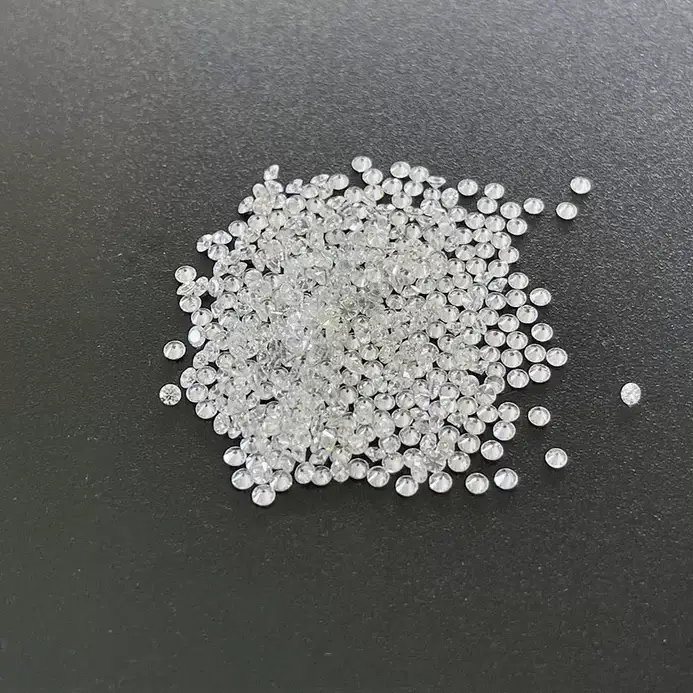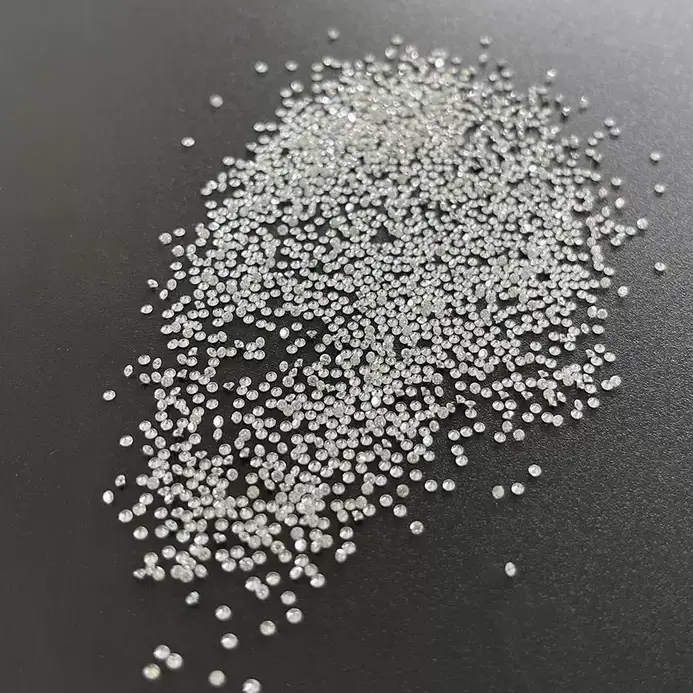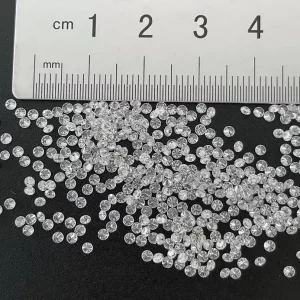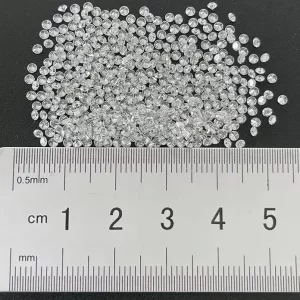0.005ct 0.04ct 0.03ct HPHT CVD Melee Diamonds FG VS VVS Round Shape
FG VS VVS 0.005ct – 0.03ct Per Pcs HPHT CVD Melee Diamonds For Diamond Jewellery
HPHT CVD Melee Diamonds Description
Nowadays people can use advanced technology to simulate the formation conditions of natural diamonds under the earth’s crust to create lab grown diamonds. This formation process is the main factor that distinguishes lab-created diamonds from mined diamonds. The chemical, optical and physical properties and crystal structure of lab grown rough diamonds are basically the same as natural diamonds. Although the place and conditions of formation are different, the essence is the same.
Lab grown diamonds is usually produced by chemical vapor deposition (CVD) or high pressure high temperature (HPHT) methods.
1. High pressure and high temperature (HPHT)
The laboratory simulates the high temperature and pressure conditions of natural diamonds when they are formed underground. HPHT diamonds are manufactured at a pressure of 5-6 GPA and a temperature of 1300-1600°C.
Low-quality natural diamonds and unprocessed natural diamonds can be processed through the HPHT process to improve color and clarity. In addition to increasing the color grade of colorless diamonds.
2. Chemical Vapor Deposition (CVD)
Scientists are able to manufacture synthetic diamonds at moderate temperatures (700°C to 1300°C) and low pressures by using CVD technology. The carbon-containing gas is pumped into the vacuum chamber, deposited on the diamond seed, and crystallized into rough laboratory-grown diamonds. The final size of the diamond depends on the time allowed to grow.
Can we distinguish between laboratory grown diamonds and natural diamonds?
Yes it is. However, only diamond professionals can identify the difference between laboratory grown diamonds and natural diamonds by using professional diamond identification equipment.
HPHT CVD Melee Diamonds Round Shape
This article is about HPHT synthetic melee diamonds. You will find out about their characteristics, including colorless, multiple sources, and Post-growth treatment. If you’re interested in buying these diamonds, read on. It will help you choose the right diamond for you! If you’re looking for the perfect diamond, consider GIA’s new service for colorless melee. In late 2016, the GIA announced its colorless melee sorting service. This service is a service that can help you find the right synthetic diamond for you.
Colorless
Near-colorless HPHT-grown melee diamonds are very similar to larger synthetics, but their small size obscures their visual characteristics and makes spectroscopy difficult. Near-colorless synthetic diamonds are generally type II, which means that they contain no measurable nitrogen impurities. However, some types of melee contain trace amounts of boron, which can be detected through FTIR analysis. Boron gives off a useful phosphorescence in HPHT-grown diamonds.
HPHT and CVD processes both produce nearly colorless diamonds, but in slightly different ways. HPHT diamonds are formed in cuboctahedron shapes, while CVD diamonds are cubic. These processes are more expensive than natural diamonds, but they closely mimic the conditions needed to form a diamond. Therefore, HPHT diamonds are generally reserved for smaller diamonds. These diamonds are also much harder and more durable than natural diamonds.
GIA has recently announced a new service for identifying Melee diamonds. The Melee laboratory in New York is now producing hundreds of thousands of carats a month. In addition, Melee diamonds can be found in all shapes and sizes, including round, princess, pear, and marquise. The GIA has recently announced a colorless melee sorting service.
HPHT synthetics exhibit a wide range of fluorescence colors. The highest concentration of boron was found in a Very Light-to-Fancy-Light blue sample. While the boron concentration in HPHT synthetics is generally comparable to that of a natural type IIb diamond, it does vary significantly among different diamonds. In order to determine the exact chemical composition of HPHT diamonds, GIA examines material released by diamond manufacturers.
When considering the authenticity of a melee diamond, it is crucial to know whether it is a natural or a lab-grown one. During the growth process, HPHT presses produce diamonds of approximately 1,000 carats in a single day. Moreover, unlike natural diamonds, melee diamonds are practically weightless. This is the reason why they can be easily detected by magnets.
The GIA’s Synthetic Diamond Grading Report shows that HPHT synthetics produce fewer colors than natural diamonds. This is a good sign as it demonstrates that synthetic diamonds are more likely to be colorless. These diamonds may also be blue in color. The GIA also reports that HPHT synthetics show less than one percent fluorescence when exposed to short-wave UV radiation.
Very Good cut grade
While traditionally, natural stones have dominated the market for near colorless melee diamonds, the recent dramatic advancements in HPHT growth technology have dramatically changed the jewelry industry. In the Chinese city of Zhengzhou, for example, diamond factories can produce over one thousand carats of near colorless synthetic diamonds a day. HPHT synthetic melee growth is an enormous industry, and some of the largest producers are located in China.
The process of annealing diamonds using HPHT CVD technology yields very similar results as that of conventional cutting processes. HPHT synthetics have a much higher degree of boron content than their natural counterparts, and it is worth noting that many of them are not colorless. They are usually brown crystals that were treated by HPHT technology to render them colorless.
When shopping for melee diamonds, you should be aware of the quality of the lab-created gemstones. While some jewelers claim that their melee diamonds are better, this is simply not true. The fake diamonds are often disguised as cubic zirconia, moissanite, and simulated diamonds. They are difficult to distinguish from real diamonds, so it’s best to shop for melee diamonds online from a reputable vendor. Not only can you buy these diamonds at a competitive price, but you can also get a certificate of authenticity.
The main characteristics of melee diamonds include brown undertones, black polycrystalline inclusions, and graining. HPHT can produce diamonds with a straw or light yellow grey color. Other signs include the presence of metallic flux, phosphorescence, and growth sector zoning. The best way to determine if a diamond is HPHT or CVD is by examining the stone’s color. The two processes differ in the amount of metal in a diamond and the intensity of the metallic elements. In general, they can both produce diamonds with high levels of quality.
HPHT CVD Melee diamonds are available in two main shapes, round and oval. They are round in shape and can vary in carat weight. These diamonds are usually sold in parcels with hundreds of other small diamonds. The parcels contain approximately 500 melee diamonds in total. They can be quite expensive, and a Very Good cut is desirable for a ring.
Multiple sources
If you’re considering investing in a diamond ring or setting, you may want to look into the multiple sources for HPHT CVD Melee diamonds. These diamonds are often cut into tiny rounds. While earlier versions of these diamonds had only seventeen or eighteen facets, modern methods of machine cutting have allowed for round brilliants with 57 to 58 facets. Before investing in this type of diamond, you must consider whether or not you want a natural or lab-grown gem.
Since 2007, HPHT synthetics have become more common, and some diamonds with this type of treatment are now marketed in jewelry. While yellowish orange HPHT synthetics are still the majority, the color of these diamonds has begun to change. Early HPHT synthetics were predominantly orange-yellow, but have since been supplanted by blue or green. This chart shows a percentage of HPHT synthetic diamonds that are colorless or near-colorless.
A diamond that was processed using HPHT may have some features of a naturally occurring diamond, but a laboratory-grown stone is most likely to be a more expensive option. Besides the color of natural diamonds, HPHT treatment can also remove the tint of brown from your stone. Because of the high temperature and pressure that is used during this process, the diamond will be permanently lighter and brighter.
One of the primary differences between HPHT and CVD is the amount of carbon used. In the HPHT process, a diamond seed is placed at the bottom of the growth chamber. The carbon atoms are then deposited layer-by-layer over the diamond seed. Pure carbon structures require more time to grow, but when nitrogen is added to the growth chamber, the process can grow 10ct crystals in three to four weeks.
Another notable difference between HPHT and CVD Melee Diamonds is the cost. Natural diamonds are formed under very high pressure and heat, and that requires a lot of time. In contrast, HPHT and CVD processes use less energy, which is why they’re usually reserved for small diamonds under a carat. However, in the case of natural diamonds, a lab-grown diamond can cost as much as thirty percent less than a natural diamond.
Post-growth treatment
The process of producing HPHT diamonds is a highly controlled growth procedure, conducted in a lab. This procedure uses high pressure and temperatures to form synthetic diamonds by fusing liquid metal and a carbon source. These conditions cause the atoms of carbon to diffuse through the molten flux and form a synthetic diamond crystal on the seed. HPHT diamonds are rare, and early gem quality synthetics often exhibited fancy color. However, recent advances in growth technology have made it possible to control the presence of impurities, including color.
The incorporation of defects in HPHT synthetics can vary, and the boron and isolated nitrogen concentrations are not uniformly distributed. To determine boron and isolated nitrogen concentrations in HPHT diamonds, IR absorption spectroscopy on faceted and cut samples was performed. The concentrations of the two elements were measured from 180 type Ib HPHT synthetics.
Although the Federal Trade Commission has not ruled on whether diamonds should be marketed as “as-grown,” the FTC is in favor of the disclosure of post-growth treatments. While this practice is generally considered to be a non-factor, the FTC has recommended that diamond manufacturers disclose their treatment methods in their sales literature. These companies have to comply with FTC regulations, but it’s advisable to consult with a diamond expert before making your final decision.
In HPHT CVD Melee Diamonds, the process of growth uses a seed diamond as a starting point. Methane is then pumped into the growth chamber using microwaves. In this way, the methane reaches a plasma state and breaks down into carbon and hydrogen. The heavier methane molecules descend into the growth chamber and precipitate onto the seed diamond. The more layers of carbon on the seed, the larger the diamond.
In addition to these synthetic melee, HPHT CVD processes are also used to create synthetic diamonds. In this process, the crystals are grown as individual, yellow seed crystals. Most HPHT synthetic melee is sold with its seed crystal attached. Larger melee diamonds grow from a seed crystal’s 100-cubic face. Some companies also produce melee with a 110-dodecahedral face.
0.005ct 0.04ct 0.03ct HPHT CVD Melee Diamonds FG VS VVS Round Shape
